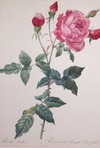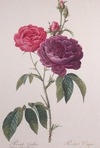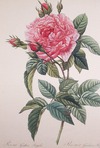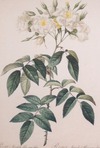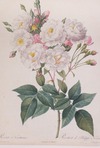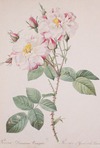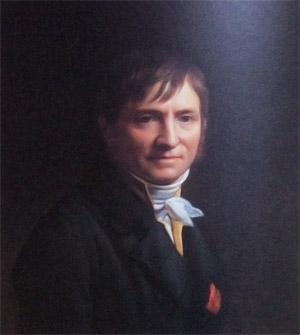
(Click images to enlarge and for purchase information.) Want to know more about prints? |
|||||||||||||||||||||
Redoute', the acclaimed French master of botanical illustration, was born in the neighboring Belgium Ardennes. He was the second of three brothers who were attracted to art and to Paris. Pierre Joseph, a child prodigy, began work as a freelance artist at the age of thirteen, taking the opportunity on his journeys to study the great masters, particularly Jan van Huysum (1682-1749). After his arrival in Paris he met the aristocrat and botanist Charles-Louis L' Heritier (1746-1800), began illustrating his botanical publications, and traveling with L'Heritier to England to illustrate a published study of rare plants at Kew Gardens, Sertum Anglium ( English Floral Wreath) 1789-1792. On their return to Paris L'Herítier secured his protégé the post of Drawing Instructor to Queen Marie Antoinette. His worthy patron soon lost her head to the Terror of the French Revolution, but Redoute’ survived and joined the Museum National d'Histoíre Naturelle, becoming its official painter. Empress Josephine Bonaparte eventually became his patron and engaged him to make drawings of her collection of garden plants at Malmaison, her estate outside of Paris. lt was during this time that Redoute' produced some of his finest work, including Les Lilíacees (1802-1816), an eight volume set in five-hundred plates, and his famous Les Roses (1817-1824) with one hundred and seventy folio stipple engraved plates. The small Octavo edition of Les Roses was published 1824-26. The process of stipple engraving and color printing give the Redoute’ Rose prints their luminous quality. Stippling is an etching process that employs dots instead of lines to form the image, which is then color printed by applying colored inks directly to the copper plate for each impression. The use of colored inks, greens and browns to print the stems and leaves, and reds and pinks to print the flowers, create a more luminous print by eliminating the necessity to paint watercolor over a back inked image. Many of the Roses depicted in Les Roses were collected by Empress Josephine in her quest to cultivate all known rose species. Malmaision contained about 250 different species and Les Roses is an important historical documentation of many those antique roses which are lost to us today. In 1828 John James Audubon, in France to market his great Birds of America, called on the seventy year old Redoute' and the two artists exchanged works! Pierre Joseph died at the age of eighty-one, it is said while painting a magnificent lily. |
|||||||||||||||||||||

 (1759 - 1841)
(1759 - 1841) 
